Expert's Rating
Pros
- Easy-to-understand interface
- Unlimited use of VPN
- ID protection service
Cons
- Ineffective parental controls
- No kill switch in VPN
- File Lock being removed
Our Verdict
Total Protection is better than ever, partly thanks to a redesign, but also the addition of ID protection.
McAfee is one of the biggest names in antivirus and has, in recent years, made a big effort to update its security products so they’re accessible to all, not just the technically minded.
A lot of antivirus software uses jargon that few people understand, so in the latest version of Total Protection McAfee has concentrated on using language that’s meaningful to everyone.
This extends to the notifications which previously could end up confusing people whereas the new messages are much clearer and certainly avoid inducing any panic. These, along with a recent facelift – at least for the Windows app – mean Total Protection is a lot more user-friendly.
The year has been dropped from the name, which makes sense. It’s an on-going subscription, not a product you buy outright.
McAfee has also added a feature that was missing previously for UK customers: ID protection. Data leaks and breaches are a growing problem, as is the fact that public knowledge of hacks can be delayed by months or even years.
Total Protection can monitor up to 10 email addresses (as well as other information, such as credit & debit cards, passport and social security / national ID numbers) and alert you as soon as any are found on the dark web. This is effectively an early-warning system that may help you to avoid identity theft and financial loss.
It’s managed from a new, online portal called McAfee Protection Centre.
The other focus is on scam protection. The sheer number of phishing emails and messages around at the moment has led it to be dubbed a ‘scamdemic’. Total Protection can warn you when websites can take control of your PC and when it’s unwise to click a link on Facebook, Twitter, LinkedIn, Reddit and other social media sites.
There’s also an integrated VPN which, unlike certain rival packages, offers unlimited data – so long as you enable auto-renewal on your subscription. The VPN itself has been improved and now offers servers in 50 locations – around double the number at the start of 2020 – and will auto-connect in the background when appropriate so the onus isn’t on you to remember.
Windows protection features
The Windows app was redesigned last year. It’s spacious, not crowded with details and also makes it far easier to see if everything is fine or not.
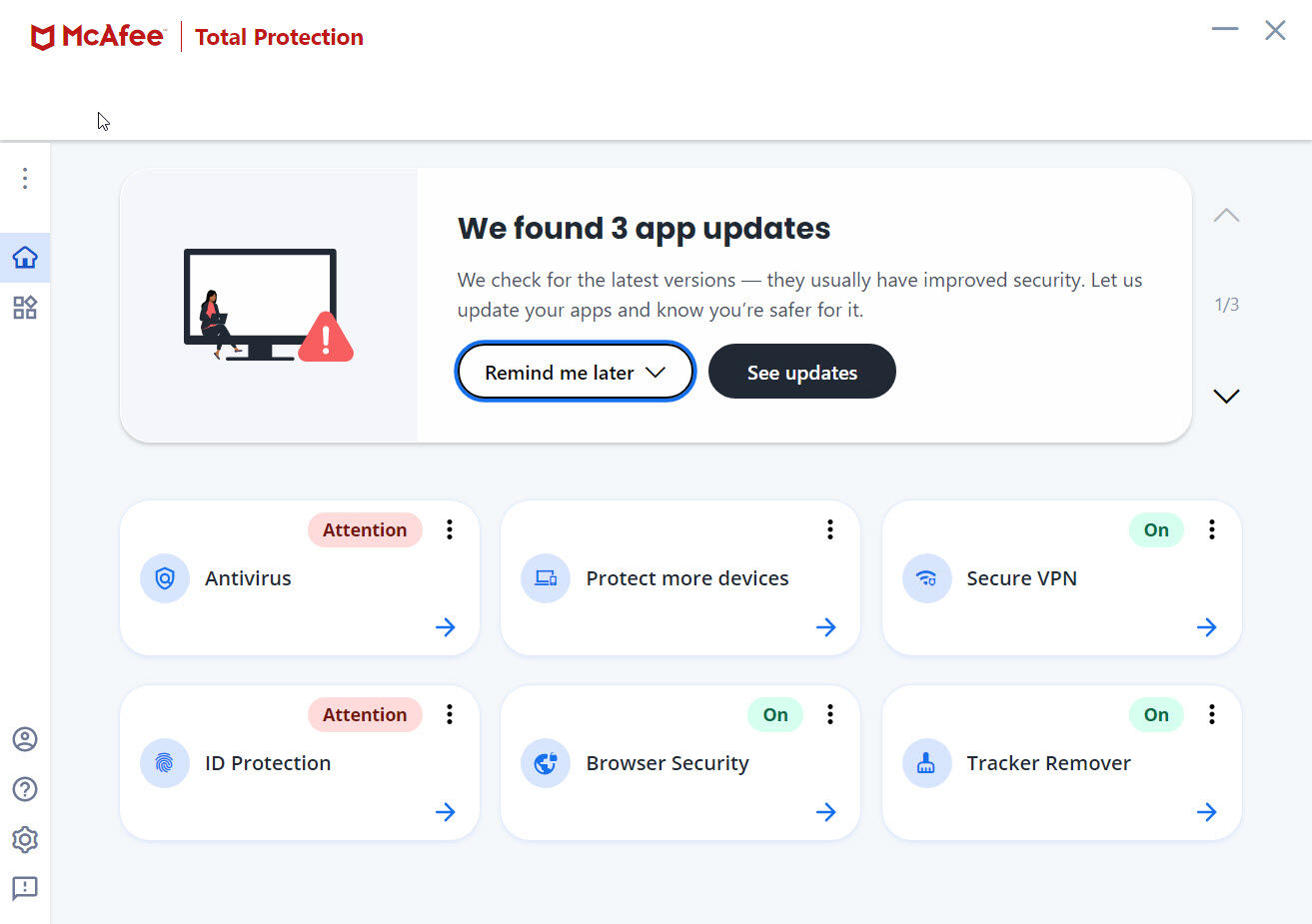
It’s been tweaked again, but is still nice and clear. A message carousel at the top works much like Bitdefender’s, offering tips and warnings about features not yet set up or – as shown here, apps which are out of date.
Below that are six tiles, some of which give you at-a-glance status reports on antivirus, VPN, ID protection, browser security and the tracker remover.
You can click the three dots to find out more about them or click the arrow to go to that feature and use it.
The VPN is built in, not a separate app, and lets you choose the country you want to connect to. As mentioned, you can have unlimited data as long as your subscription is set to auto-renew, which is a real advantage over rivals which often make you pay extra for unlimited use. The main drawback, though not unusual for a VPN bundled with antivirus software, is that it won’t unblock your favourite streaming service: it’s for security, not entertainment.
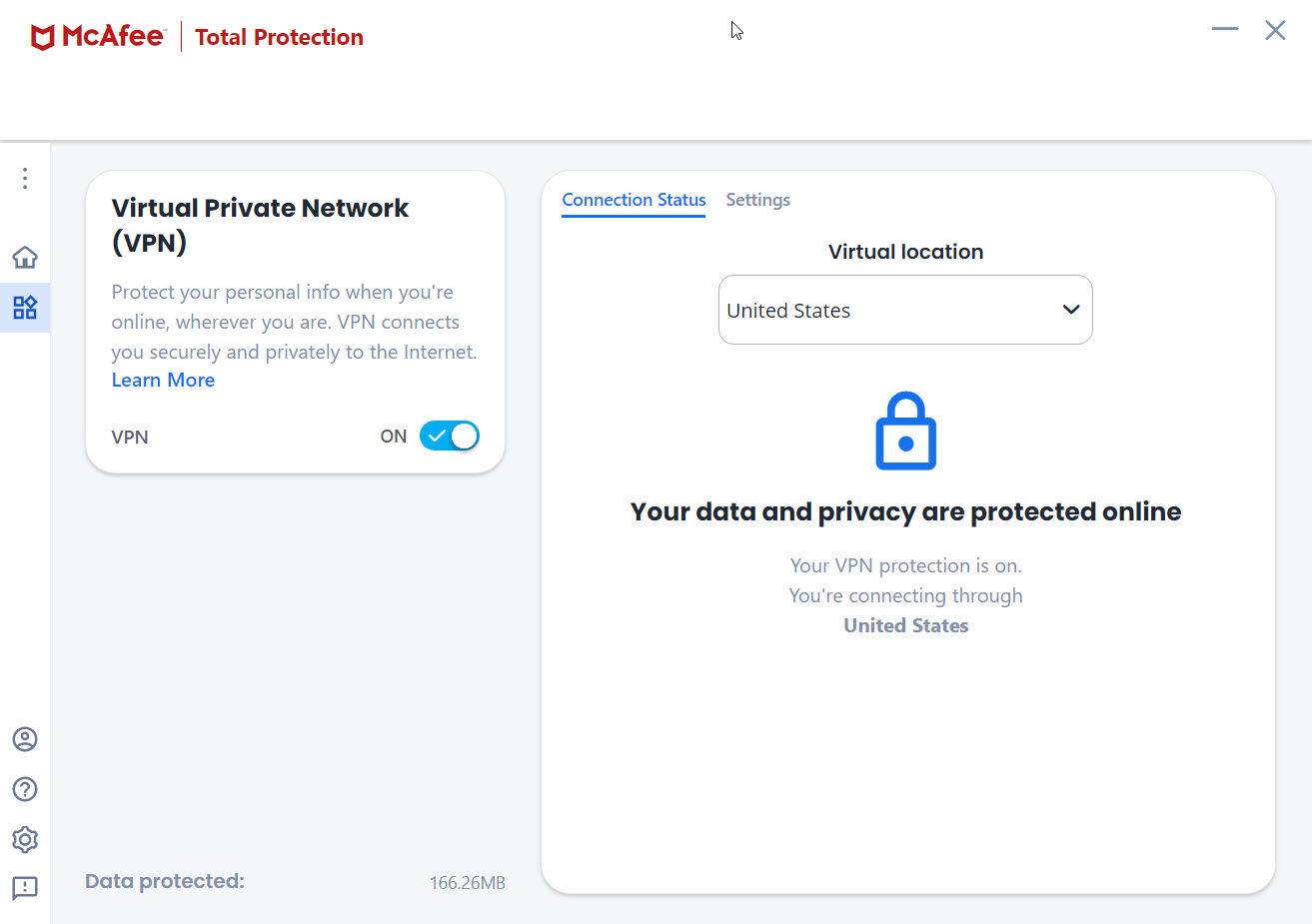
Some features are not built in, such as the True Key password manager and the File Lock app. File Lock, which encrypts sensitive files to protect them from unauthorised access (and from ransomware) is being retired in February 2022 because “there are other more modern and flexible options of storing files securely.”
So, don’t create any vaults with this feature.
True Key is a separate app on Windows and iOS, but has recently been integrated into the main Mobile Secuity Android app, along with the VPN.
It’s a fine password manager that supports lots of multi-factor authentication options, including fingerprint recognition if your laptop or phone supports it, and even facial recognition. It’s even possible to reset the master password if you forget it by using other authentication methods.
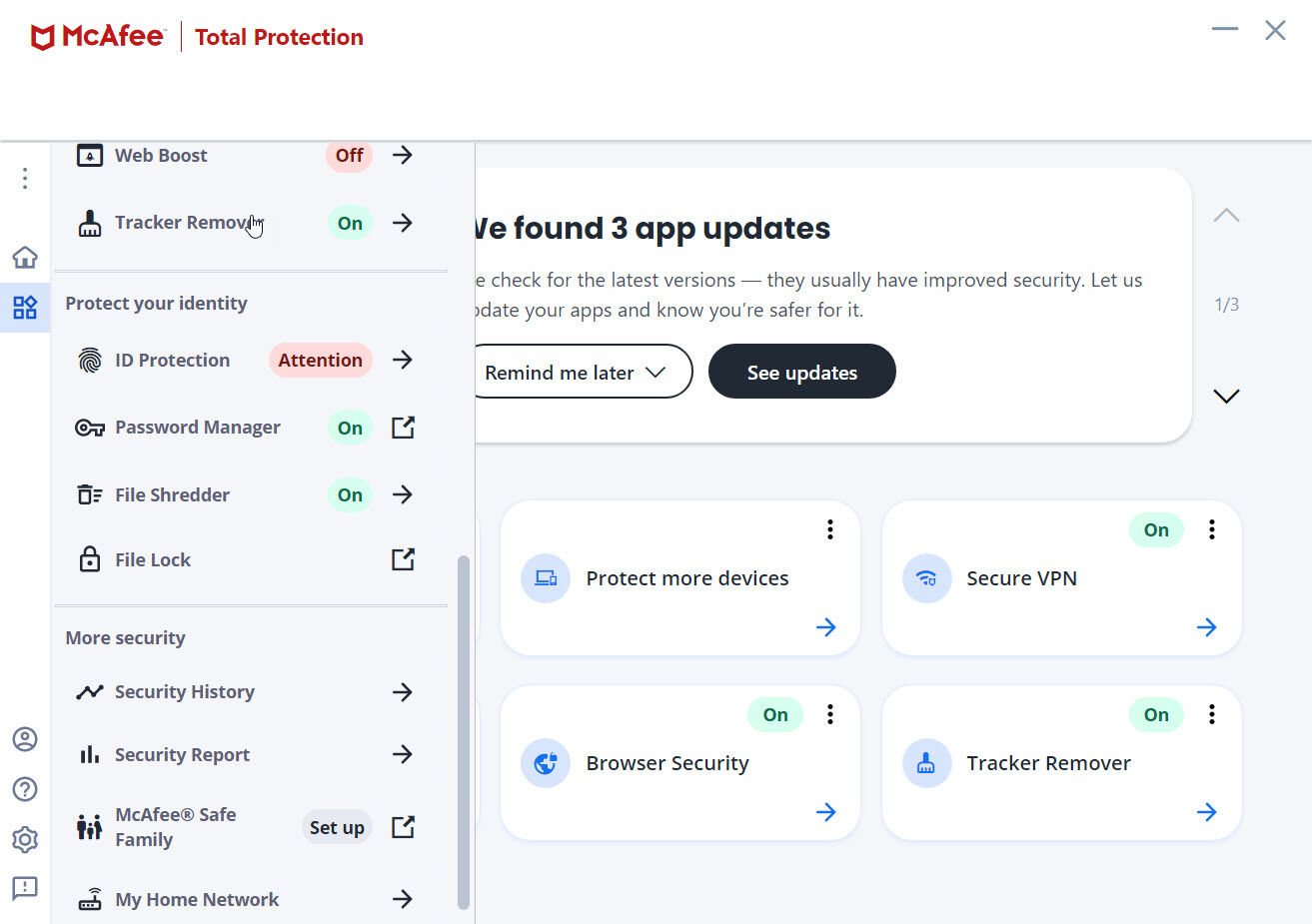
The other key feature that’s still a separate app is Safe Family, McAfee’s parental control software. This isn’t included at all if you only buy Total Protection for 5 devices, but it is if you go for 10. However, there’s better parental control software out there, such as Qustodio, so don’t pay extra for this.
If you want to know why then, briefly, Safe Family has more limited platform support (no macOS, no Amazon Fire OS, no Chromebook), doesn’t offer a web portal for management, won’t filter websites if the child installs an ‘off brand’ web browser and it’s not even smart enough to prevent kids from uninstalling it on Windows and iOS. You’ll just get a notification that they’ve done so.
A useful feature is Secure apps which monitors for updates to any installed apps and lets you click a single button to install all available new versions. It also shows which are deemed ‘critical’ so you can install just those if you prefer.
Though ID protection has been added, cloud storage is one feature you won’t find. This isn’t a big issue as it’s not really a security feature and so doesn’t detract from the protection offered. But it remains a bonus when you subscribe to rival packages such as Norton 360.
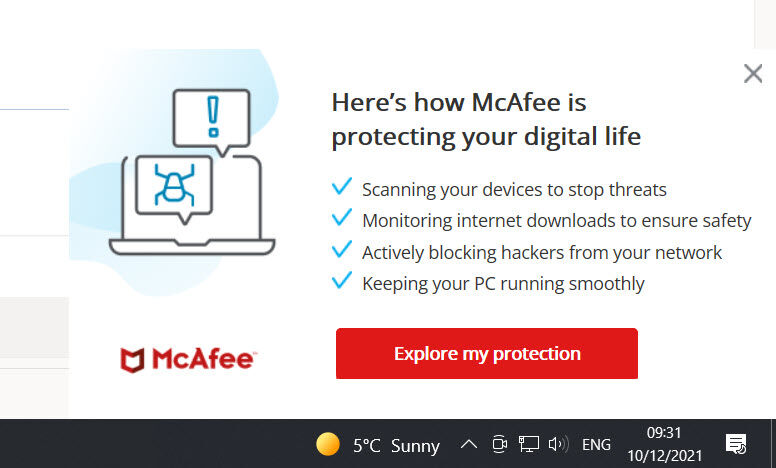
As time goes on, you’ll see various pop-ups which are all useful and informative. One reminds you what your subscription is doing and offers a button to see the Total Protection app (for users who would otherwise not bother to launch it), and others appear in the appropriate context, such as offering Web Boost when you’re on a page with an auto-playing video and Web Advisor if you don’t set it up for a while.
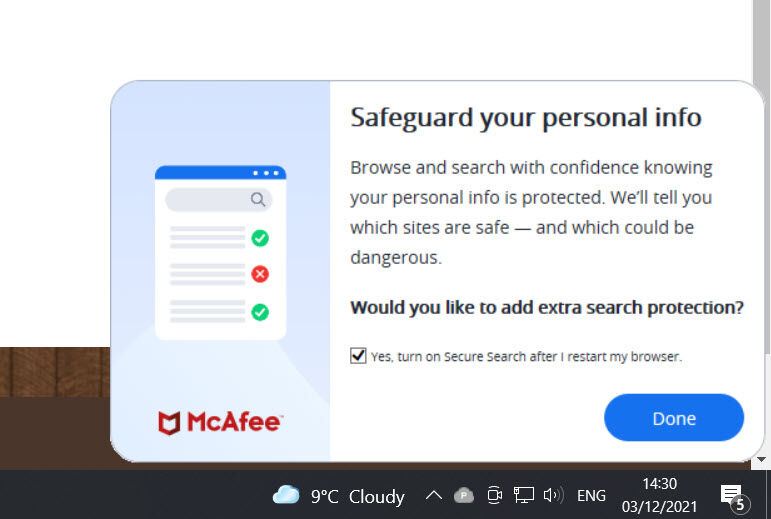
The latter marks websites in search results to say if they’re safe or potentially dangerous. You’ll also be offered Secure Search, which changes your search engine from Google to a Yahoo-based one. Fortunately you can tweak Web Advisor’s settings so it marks up search results in any search engine.
It will also colour-code links in YouTube, Twitter, Reddit, Facebook, Instagram and LinkedIn so you can again avoid those which could be unsafe.
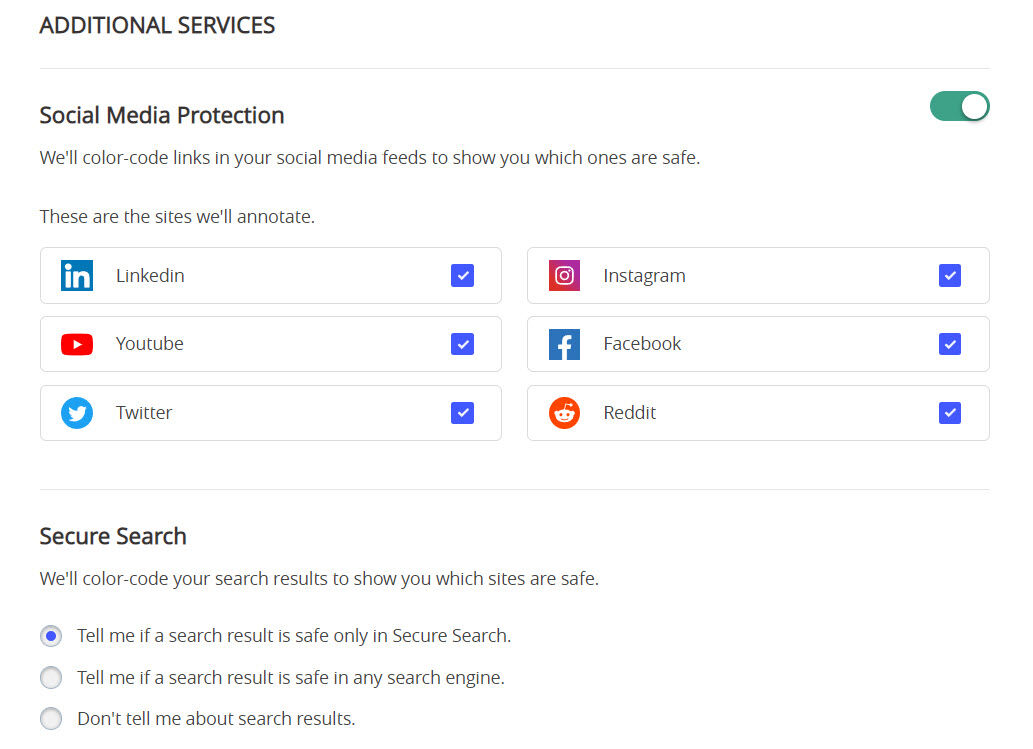
Overall, Total Protection’s ability to help you avoid dangerous sites and links in messages and emails is very good.
There are a few things that remain minor frustrations. One is that the default virus scan time of 4am virtually guarantees your computer will be switched off, so it won’t happen.
It’s similar with the QuickClean tool, which clears cookies and clears space used by temporary internet files. That is also scheduled to run at 6am and, confusingly, is called Tracker remover in the updated interface.
Once you’ve gone through the initial process of setting up protection that can’t be automated – such as enabling Web Advisor in the browser(s) you use – there shouldn’t be any need to open the app or change any settings.
When something happens that needs your attention, the notifications clearly explain what happened and whether or not you need to do anything: typically you don’t.
If you want zero notifications (which isn’t a good idea) you can turn off all alerts. But since some of these will warn you when a program disables the firewall, for example, it’s better to leave the alert settings at their defaults.
So long as you’re happy to look elsewhere for parental control software and a file encryption tool, McAfee Total Protection does a great job.
Malware protection
McAfee generally does very well in independent testing, and while the latest report from SE Labs shows it has slipped a bit in the rankings between July and September 2021, it’s still one of the top 10 security products.
It failed to detect five threats, and failed to block 1 of the 94 (out of 100) that it did detect. That fact it was compromised six times is disappointing.
To put this in context all of the top ten were compromised at least once, with Kaspersky by four threats and Norton five.
Total Protection scored 100% in the legitimate software tests, meaning it didn’t declare any were threats and, overall, still scored the same AAA rating as Kaspersky and Norton.
In AV-Test’s September and October report, Total Protection passed with flying colours, achieving 100% protection against 0-day attacks and detection of malware discovered in the previous four weeks.
It also scored maximum points for usability and performance (the latter meaning it doesn’t have a negative impact on your PC’s performance).
It fared just as well in AV-Comparatives testing from July to October 2021 not being compromised by a single threat, and reporting zero false positives.
If you track malware protection test results as we do, you’ll know all products vary a little over time, and this is – overall – a great result for Total Protection.
As a bonus for subscribers with auto-renewal enabled, McAfee techs will remotely deal with a virus infection (that has managed to get past the defences) and give you your money back if they can’t remove it.
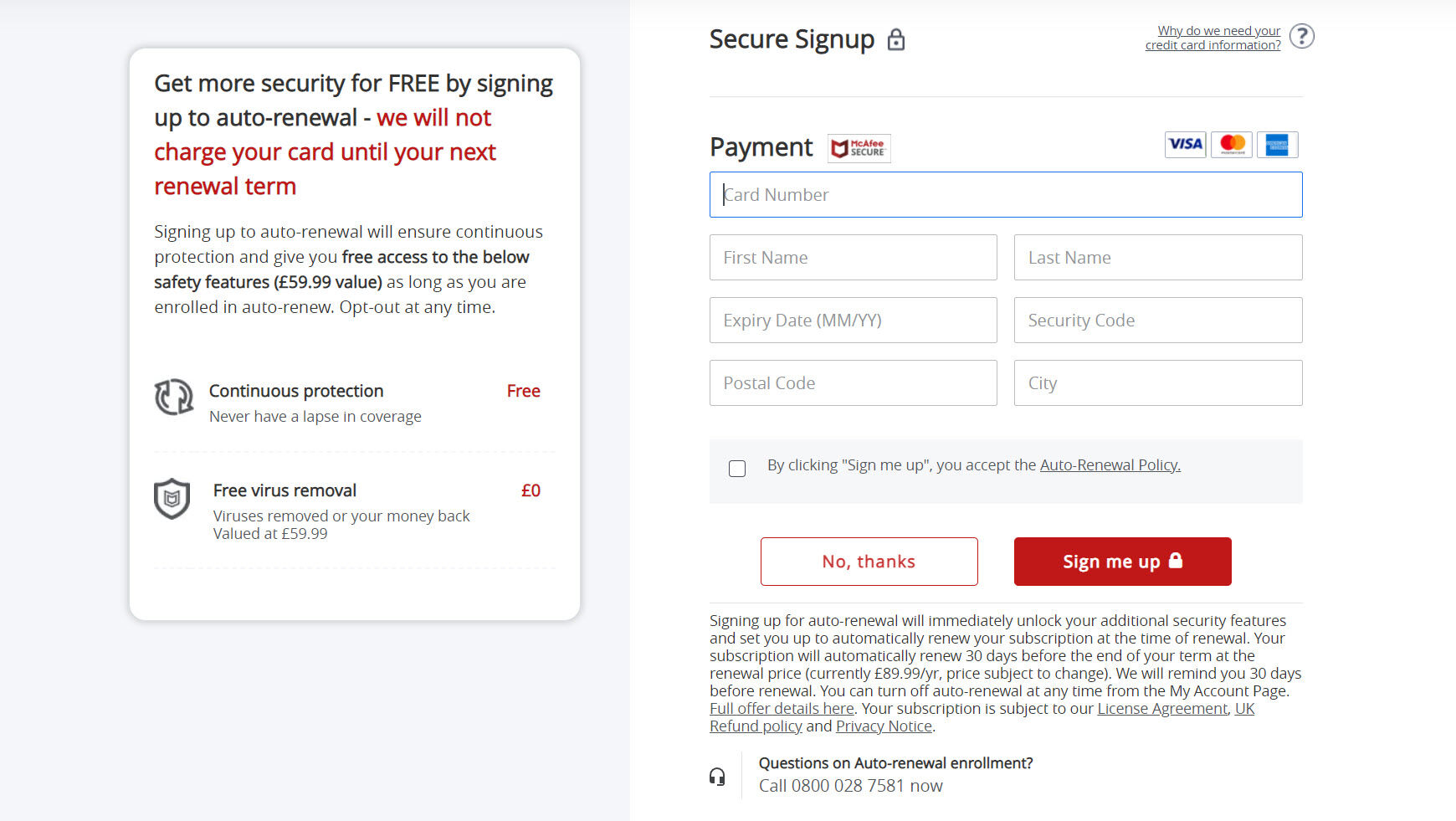
Mobile apps
As with all security software features in the McAfee Mobile Security apps vary between Android and iOS but both include the usual stuff, including web browsing protection (including phishing) and the ability to locate and wipe your device remotely. There’s also Thief Cam, which allows you to take pictures of whoever steals your mobile device.
In late 2021, the Android app had a huge overhaul, merging the VPN and True Key apps into the main security app, and getting the same makeover as the Windows app so it all looks the same across your devices.
A nice touch is the ability to lock specific apps so they can only be used by those who know the passcode.
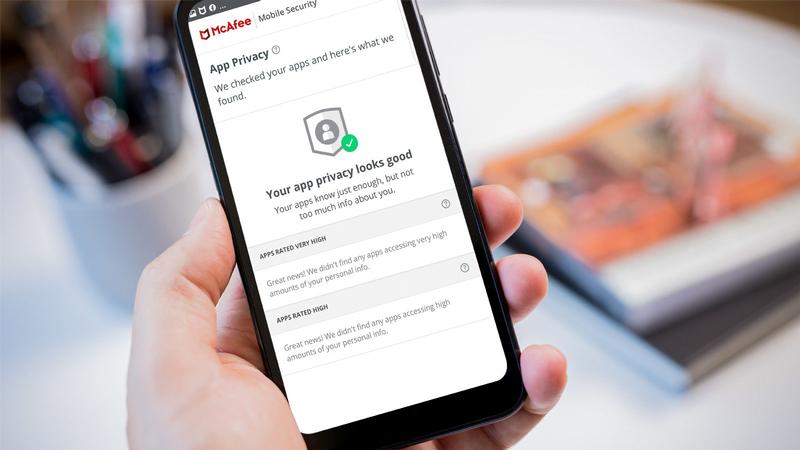
There’s also a privacy check that scans installed apps for the permissions they’ve been granted and warns you when they are “accessing an unusually high amount of personal info”, along with a big button to delete the app. That’s a bit drastic, especially if you like or need the app in question, so there are also options to edit the permissions and restrict them to what you consider essential.
Of course, ID protection is now baked into the apps on both Android and iOS.
Annoyingly, the QR code you can scan to install the app doesn’t contain your user ID, so you have to enter a ‘subscription code’ to use the apps. On iOS at least, this was an impossible task when I tried: it wouldn’t accept the activation code and wouldn’t accept the codes presented on the web page displayed prior to installing the app.
McAfee Protection Center
We’ve talked about ID protection already, but it’s worth also talking about the new web portal. It’s the main way to manage the details you’re protecting and the only way (currently) to see the new Protection Score. McAfee says it will be added to the apps in the next few months.
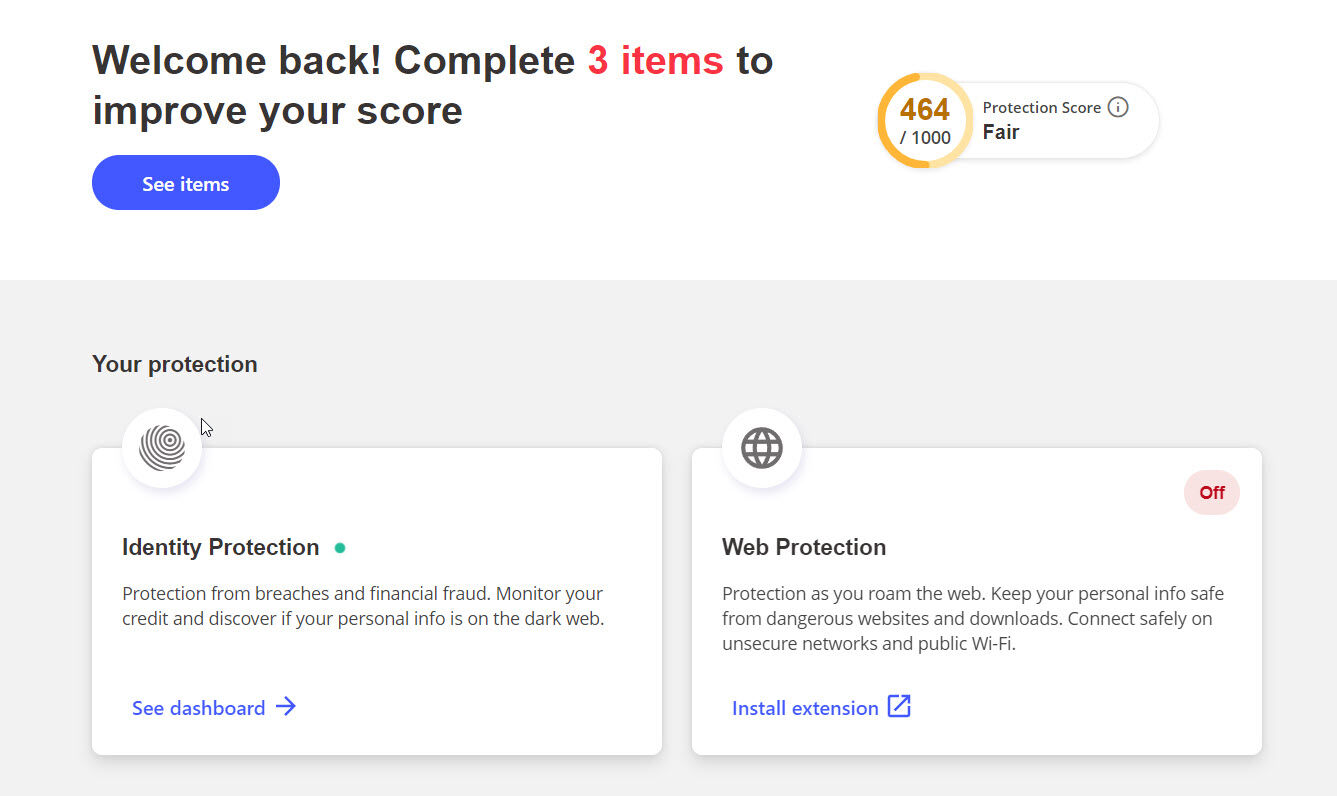
Initially, you might consider it a gimmick, but instead of being yet another form of gamification, it’s designed to ensure you’re using all the features on offer, as well as guiding you through setting it all up. The score increases as you add an email address to monitor, for example.
Again, if you have auto-renewal enabled for your subscription, you’ll find you can enter all your details, including passports, phone numbers, tax IDs, national IDs, credit cards, usernames, bank accounts and health IDs.
You might feel slightly uneasy handing this info over but, frankly, I’d rather hand it to McAfee than some of the ID protection startups that haven’t built up a reputation for trustworthiness over the years. And I’d rather hand it over than not have an early heads-up that my passport or credit card details have been leaked.
As you can see below, you can only monitor 10 email addresses if you have auto-renewal disabled. McAfee says you can turn it on to get all the features, then disable it after 11 months (of a 12-month subscription) if you really don’t want to continue paying.
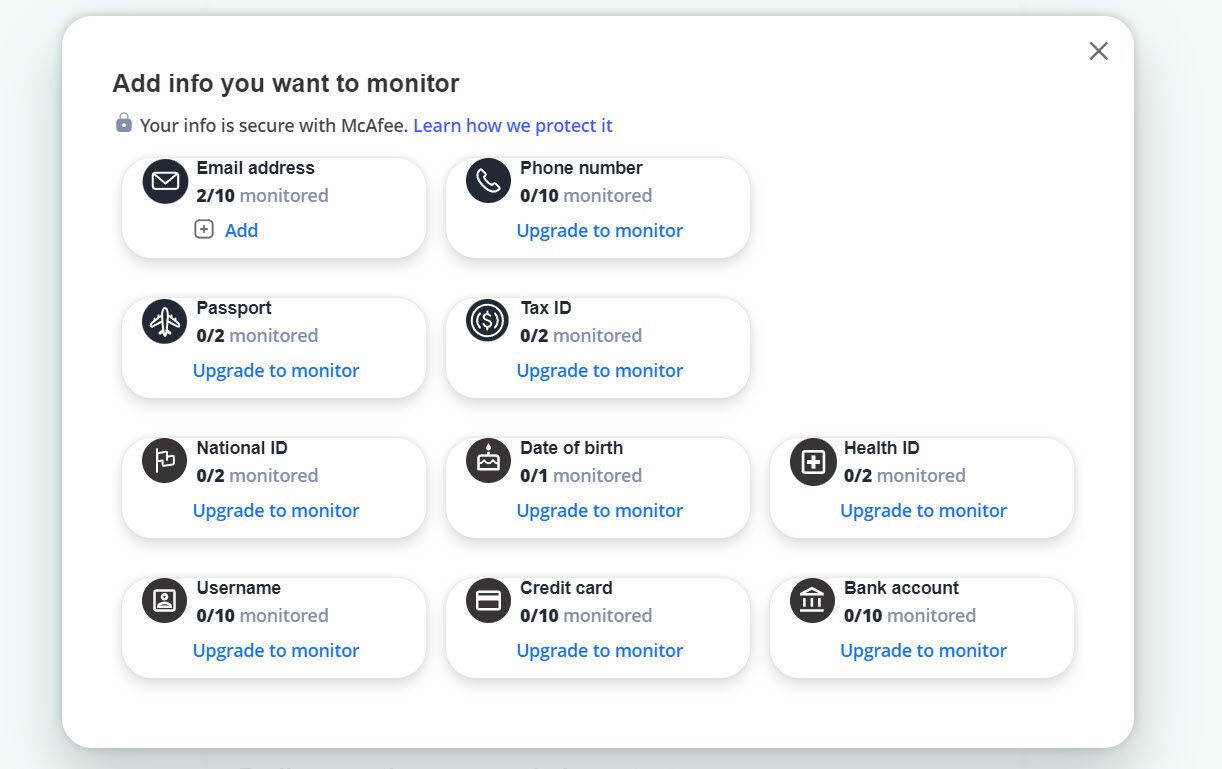
You’ll get an email if your info is found on the dark web, and you’ll have to enter a one-time code (emailed to you) to view any sensitive information included in the breach, such as the password.
This is done for security, but it’s very frustrating if you’ve had an email address for a long time which has been included in dozens of breaches as you’ll have to wait for and enter the code to see the password stolen for each entry. Sometimes you’ll see a message saying “We know your password for this account was stolen but we can’t see what it is. Good news is you can change it anyway.”
However, even if you don’t know the stolen password, you only need to change the password once to address all previous breaches for that account.
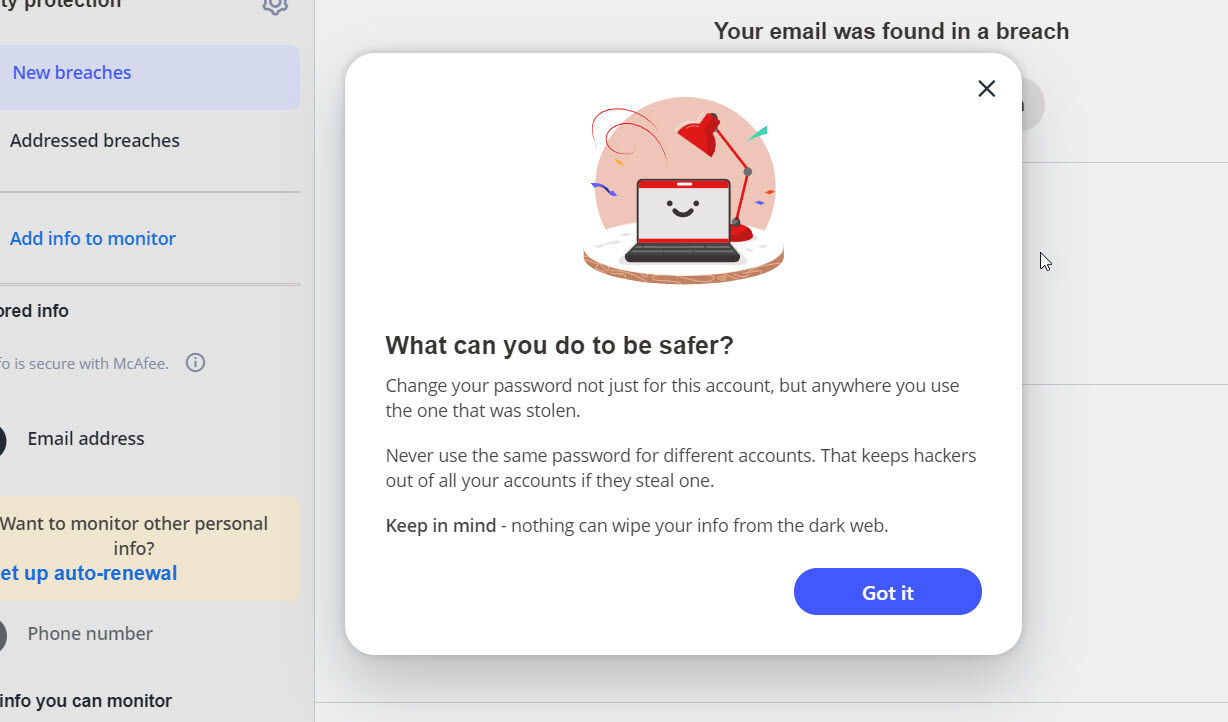
The problem in Protection Center is that you can’t select all breaches and declare them “addressed”. You have to click on each one in turn, which is a slow process. And that’s the only way to build up your protection score, as leaving them unaddressed harms that score.
For some breaches, there’s a link to change the password, but more often than not, there isn’t, so you have to figure out how to do it youself.
But even the new, comforting messages tell you that there’s nothing you can do if your address or other details that you can’t change have been leaked. You just need to be more aware of potential phishing scams – they’re more believable when the scammer knows a lot about you.
VPN
McAfee’s Secure VPN service is bundled with the 1, 5 and 10-device versions of Total Protection. Just note that the VPN service can only be used on five devices, even if you go for the 10-license version.
Behind the scenes, the VPN uses TunnelBear’s service, which McAfee bought a couple of years ago.
One of the useful features available only in the Android app is App level protection. It means you can choose which apps use the VPN connection and which don’t.
When you click on it in the Windows app, you get 50 countries to choose between, or you can leave the menu set to ‘Fastest Connection’.
It’s very simple to use, but that’s normal for a VPN. What’s surprising is that there are still very few settings, and there’s no kill switch at all. That means you won’t know if the VPN stops unexpectedly, leaving you unprotected.
The good news is that we found speeds had improved considerably compared to last year. When tested in December 2021, it wouldn’t fully unblock Netflix. It worked in the sense that it didn’t show a ‘you’re using a VPN’ message and allowed videos to be played. But it didn’t show NCIS or other US-only TV series and films in the search results.
Price & Availability
McAfee – like virtually all its rivals – offers a discount for the first year of your subscription. At the time of writing, you can get a 10-device subscription for less than half price: £39.99 instead of £89.99.
You’ll only save £5 by dropping down to the five-device subscription (£10 after the first year), and a further £5 if you need protection for just one device.
In the US, the deals are slightly different where you can opt for a two-year subscription for $59.99 ($29.99 per year for 10 devices). And don’t forget that additionally includes ID protection, which you don’t get in the UK.
If you have a lot of PCs, laptops, phones and Macs that need protecting it does represent good value. Just remember you can still use only 5 devices with the VPN simultaneously.
Take a look at the offers and sign up here.
If, on the other hand, you’re looking for something cheaper we’d recommend visiting our round-up of the best antivirus software.
Verdict
McAfee has done a lot to improve Total Protection over the past couple of years and the simplified, comforting alerts are very welcome.
Protection is very good overall and there are a lot of useful features, some of which need enabling before you’re protected, but it’s obvious which these are and it’s not difficult to sort out.
ID protection, previously only available to US subscribers, is now available in the UK, and monitors a whopping 49 types of PII (Personal Identifiable Information).
The VPN service is again improved and while there are still some glaring omissions such as a kill switch, it now lets you pick from 50 different countries and – unlike most competing security suites – doesn’t put a daily limit on how much data you can put through it.


